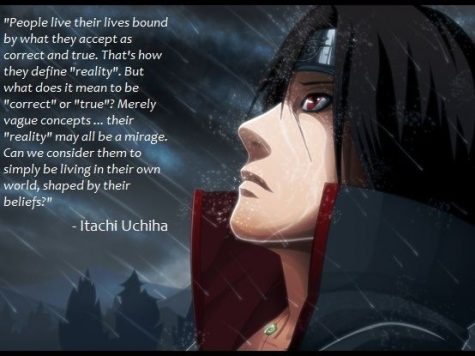Sharing entertainment can bridge cultural divide
What is culture? Culture is the social behavior and norms found in human societies. But how can we learn about these societies? How can we explore in different ways other than history books, classrooms and museums? How can we learn how to solve issues and culture clashes through simple, rational comprehension of one another’s understanding of why and what we can do to diffuse a really bad scenario? Or to sum all of these sequential questions, how can we see from the perspectives of different cultures how life should be? And, how can we do it without being bored reading a book? We could do it with manga or by invading someone’s space.
Park University has plenty of diversity throughout the halls and facilities of the campus. There are people from all over the world like Africa, Egypt, China, Europe, Brazil, Mexico and other countries who bring so much variety to the table when it comes to an assortment of cultural differences. They have their own languages and rituals reflected in their specific methods of entertainment. The kind of entertainment I would like to discuss and study is a simple form of recreation we all like to watch or we may be able to grow toward.
I’m talking about anime. There are different forms of anime. It goes from simple American cartoons that show off the American dream such as Tom and Jerry, with the white picket fence with a cut lawn, full home and a couple of pets to stabilize the house from infestation and outside intruders. Add in a BBQ to top it off, signifying the norm of U.S. tradition of the American people. Or if we switch over to the traditional anime side of things, this simply translates to Japanese cartoons; Naruto (Naruto Shippuden) or Dragon Ball Z, for example.
These two shows came out in the 80s and 90s and were praised for their wonderful storytelling mixed in with intriguing ways to convey their own messages. They projected their own morals and ethics toward the audience. These shows went down to the basis of what a person can be when facing villainy or heroism, when a man or woman is weak in the face of failure. There are time periods, styles and traditions that are portrayed closely in these extravagant shows.
A perfect example would be a character in the series of Dragon Ball (DBZ) known as Chi Chi. She is a hardworking, stay at home mother who makes sure her children get the proper education and acceptance in the best scholarly programs anywhere. It doesn’t matter if the world is going to end or not, Gohan and Goten will be studying on a regular basis with a stable job and a promising future. This implies how much the role of a family holds dear to the normal Japanese family heritage. They emphasize not being taunted by the lack of education or a husband without a supportive job.
To be honest, in American culture people usually try to find a way out, and their ways are not usually the education route. It’s usually through sports, music, and joining the military at some point. That’s why we can observe the differences and research these cultures, comparing ourselves and everyone else around the world. We could figure out our differences and spark curious questions because of the cultural difference shown in these animations and loved around the globe.
Another example can be Naruto Shippuden, a boy who was bullied and tortured throughout school. He figured out how to break past this obstacle onto a new path of his dream to become Hokage of the village. The Hokage is basically the president of a whole country, earning the respect and honor from all of his friends and foes.
Some kids his age are in this predicament, sadly. This relatability builds up more than just pity or emotion within a person. It’s a connection that makes the audience want to learn more about Naruto and his surroundings. In this case the surroundings involve Japanese tradition like the formalities that follow when you walk in a dojo of Neji Hygua, a bow and why people used to call masters or sensei of art and jutsu, which was a reality in old times in the Asian culture. Opening a new door to these energies, called chakra, is another route of education and beliefs the Asian community has.
We can unite a lot of people on a level that’s probably unimaginable to the modern politician. Dissecting these shows can be like dissecting people. We can see what they really feel about life, philosophy, people or the system. Giving us a brand new look on things beyond the simple physicality and diplomacy from a prominent figure resulting in war or oppression about the similar traits would be a huge study.
Another promising example would be a character who stayed loyal to his country, protecting his own but taking lives of the innocent for peace in the village hidden in the leaves, Itachi Uchia. Besides behavioral psychology, this can parallel the variety of cultures to our own to accomplish a greater goal, ultimately carried out inside the classroom.
We could get students and the general population into a deep study where a mass of fans agrees with a show’s philosophy or methodology on how to effectively create solutions. Of course, people have the power to do whatever is needed for the actual greater good if push comes to shove. I just believe some of these shows really hold a deeper meaning and a free ticket toward something you can learn anew.
We need a system that’s built on more than morals and ethics. We need to prepare people for a harsh world, tackling it at the same time as influencing others that the old way is not the right way anymore. A couple of old ways are important, don’t get me wrong, but these amines and the people who watch them and learn from them can really make a difference in this world. Ethically, morally, politically and personally handling problems and issues that ring out in our place of so called security will map out our destinies on the path of failure instead of success.
“Those who breaks the rules are scum, but those who abandon their friends are worse than scum.” – Kakashi Hatake (Naruto series)
Your donation will support the student journalists of Park University. Your contribution will allow us to cover our annual website hosting costs, freeing up other funds for equipment, printing and training.




